Mobile App Development Process: Things You Need to Know
Date
Oct 13, 25
Reading Time
12 Minutes
Category
Low-Code/No-Code Development
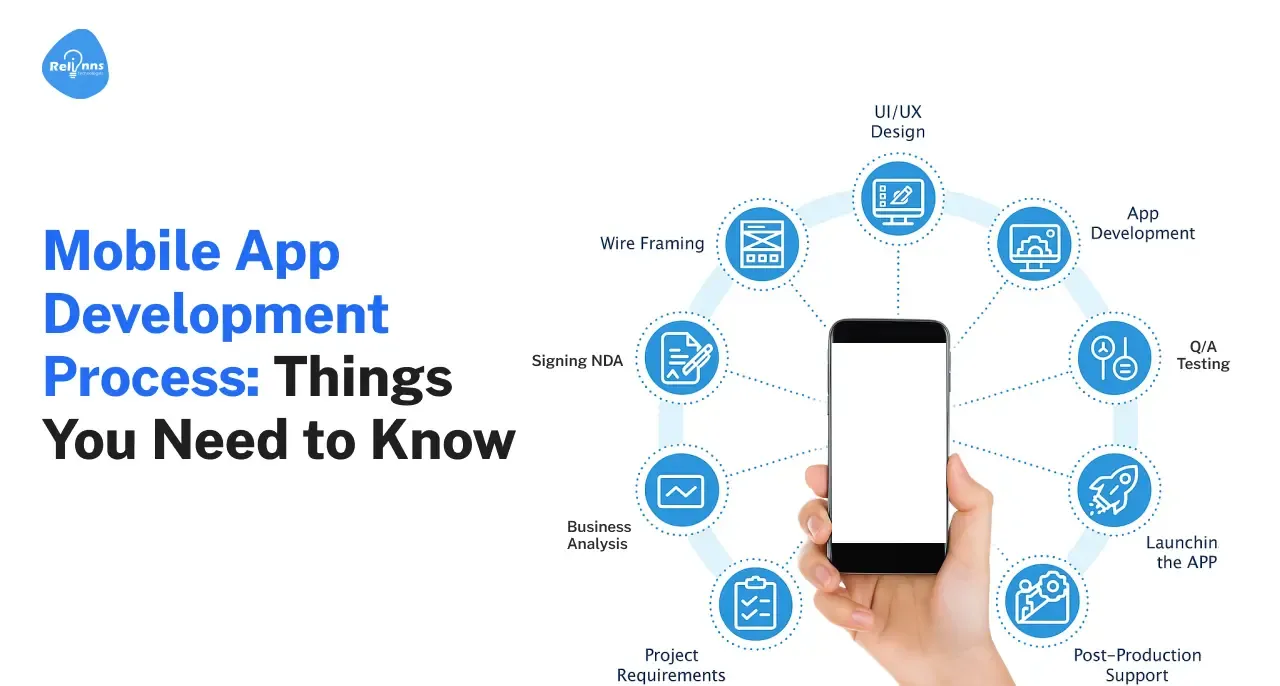
Every app begins as an idea, but not every idea becomes a success. The truth is, many apps fail not because of the concept, but because the mobile app development process behind building them is weak.
The process of mobile app development is what transforms a rough thought into something people actually use and enjoy. Without the proper steps of the mobile app development process, even the most brilliant idea can collapse.
In this blog, we’ll break down the complete journey from the first spark of Ideation to a fully working app. You’ll learn what each stage involves, why it matters, and how following the proper mobile app development process can make the difference between failure and success.
What is Mobile App Development?
Every tap, swipe, or scroll on your phone happens because of mobile apps. However, behind those apps lies a structured mobile app design and development process, which involves creating software applications that run on smartphones and tablets.
In simple terms, mobile app development combines design, coding, and testing to turn an idea into a working product. It’s not just about writing code. It involves understanding user needs, selecting the right technology, and ensuring the app works seamlessly across devices.
Mobile apps fall into four main categories:
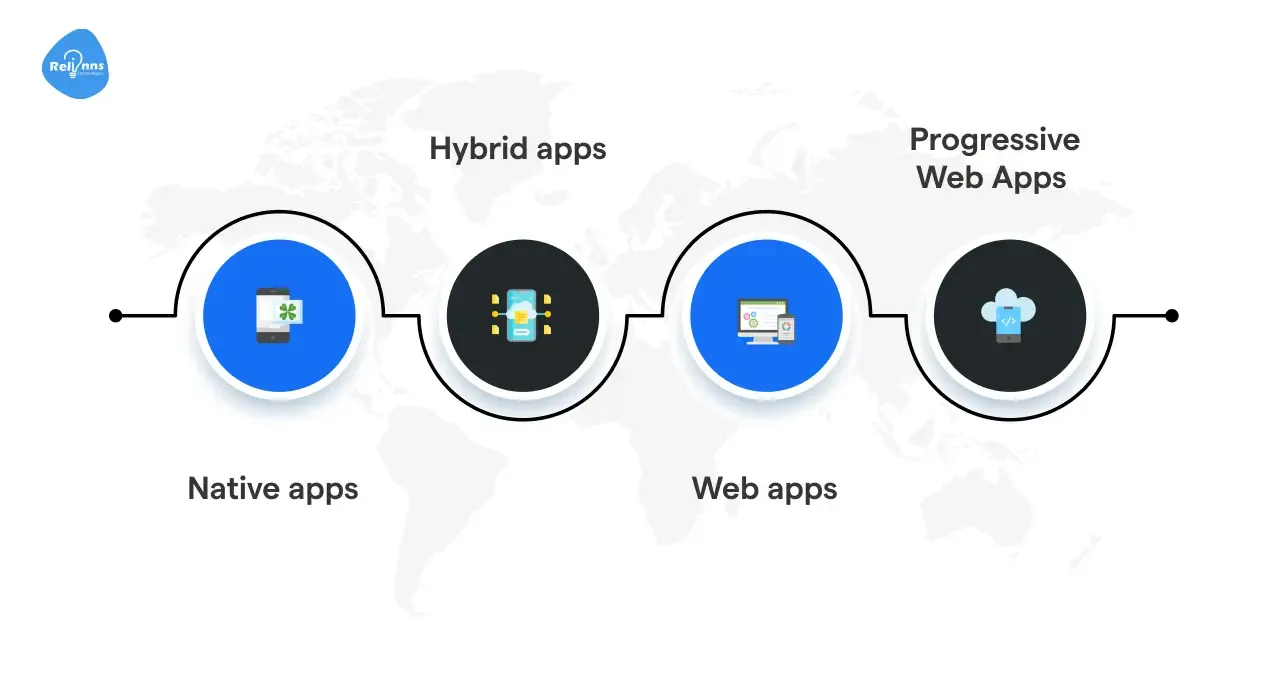
- Native apps (built for a specific platform like iOS or Android)
- Hybrid apps (a mix of native and web features, often cost-efficient)
- Web apps (lightweight apps accessed through browsers)
- Progressive Web Apps (PWAs) (web apps with native-like features such as offline access and push notifications)
In simple words, the mobile app development process flowchart is about bridging an idea and the end-user experience. To make that bridge strong, you need a well-defined process.
What is the Mobile App development Process?
An app is never built in a single step. What appears to be a simple product on your phone actually undergoes a series of carefully planned stages. This structured journey is known as the mobile app development process.
At its core, it’s a framework that guides an idea from concept to launch. Instead of diving into coding right away, businesses follow a defined mobile app development process to ensure the app is useful, scalable, and aligned with user expectations.
Every stage plays a role in shaping the final product.
- Breaking down a complex project into manageable steps.
- Reducing costly mistakes by testing ideas early.
- Ensuring faster delivery with clear timelines.
- Building apps that provide better user experiences.
In short, the process of mobile app development is about bringing structure to creativity. It balances innovation with execution, making sure ideas don’t just remain on paper but reach users most effectively.
What are the methodologies of mobile app development?
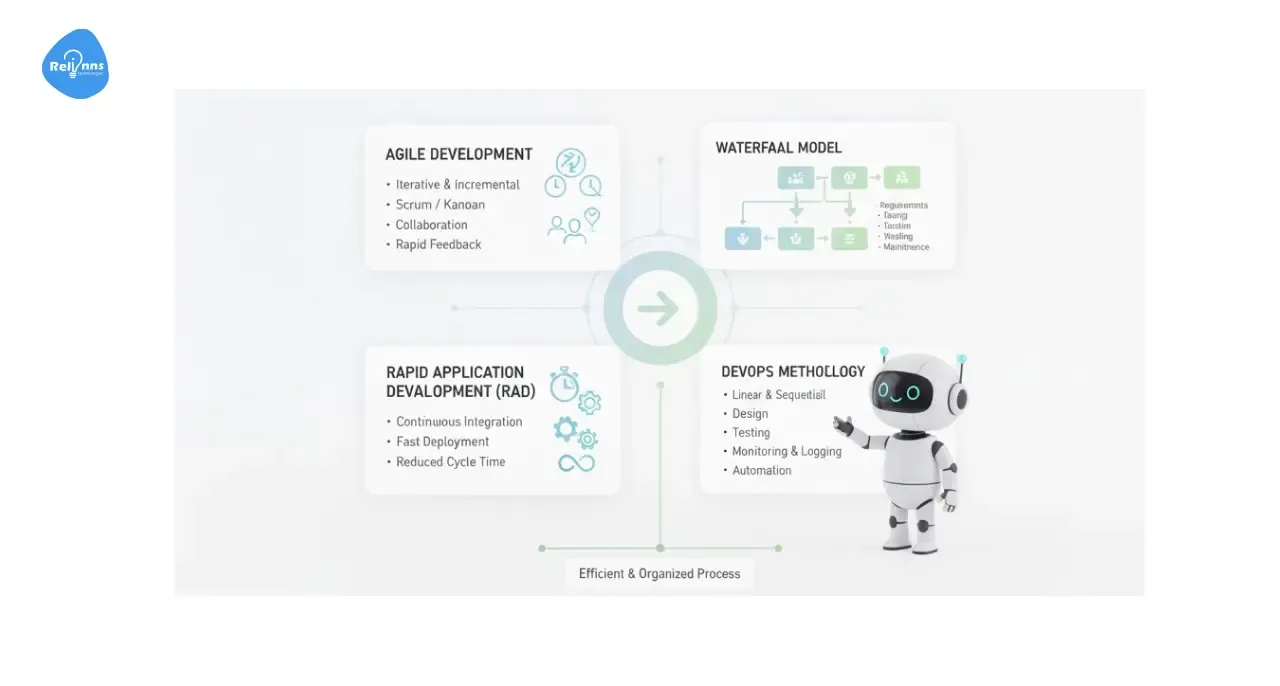
Choosing the correct methodology is crucial for building apps successfully. Here are the most common and emerging mobile app development methodologies:
- Waterfall Methodology – A linear model where each stage (planning, design, development, testing) is completed before moving to the next. Best for small, fixed-scope projects.
- Agile Mobile App Development Process – An iterative approach with short Development Sprints, allowing flexibility, faster delivery, and continuous feedback.
- Scrum Framework – A subset of Agile that organizes work into sprints with defined roles to enhance collaboration.
- DevOps – Combines development and operations to enable continuous integration, Backend Integration, and deployment.
- Feature-Driven Development (FDD) – Focuses on delivering small, incremental features for better progress tracking.
- Lean Development – Reduces waste by focusing only on features that provide maximum user value.
- Rapid Application Development (RAD) – Prioritizes quick Prototyping and testing over long planning cycles.
- AI-Assisted Development – Uses AI for code generation, bug detection, and predictive analytics to speed up the steps of the mobile app development process.
- Low-Code/No-Code Platforms – These tools enable businesses to design apps visually, making the mobile app development process quicker and more efficient.
Every project is different, and if you’re unsure which approach works best, Relinns can help you choose the right strategy for a smooth app development journey.
Pros and Cons of Native, Hybrid, and Web Apps
Now, let’s take a quick look at the pros and cons of these three main approaches, which are as follows:
| Type | Pros | Cons |
| Native | -Top performance & responsiveness -Seamless UX experiences -Full access to device features (camera, GPS, sensors) -Works robustly offline -Better energy efficiency (uses fewer resources vs web apps) | -High development & maintenance cost (separate builds per OS) -Longer time to market -Updates must go through app stores -Needs skilled native devs -More storage is used on the device |
| Hybrid | -Faster development (single codebase)-Cost-efficient -Cross-platform reach -Easier maintenance (shared code) -Suitable for MVPs & moderate feature sets | -Weaker performance on heavy task -Sometimes, there is limited access to advanced device features -App feel may not be fully native -Reliance on third-party plugins -Inconsistent behavior across platforms |
| Web | -No installation (runs in browser) -Very low cost & fast deployment -One codebase for all devices -Instant updates (no app store approval) -Web SEO advantage for discoverability | -Performance depends on browser & connection -Limited offline support -Less access to native hardware -Energy use & resource inefficiencies vs native -Not ideal for complex features |
The Basic 7 Mobile App Development Process Steps:
Building an app is not just about writing code; it's also about designing and implementing it effectively. It’s a structured journey with clear stages, each ensuring the app moves from an idea to a usable product without any failure.
Below are the 7 steps of mobile app development, explained in detail.
1. Ideation and Research – Defining Your Goals
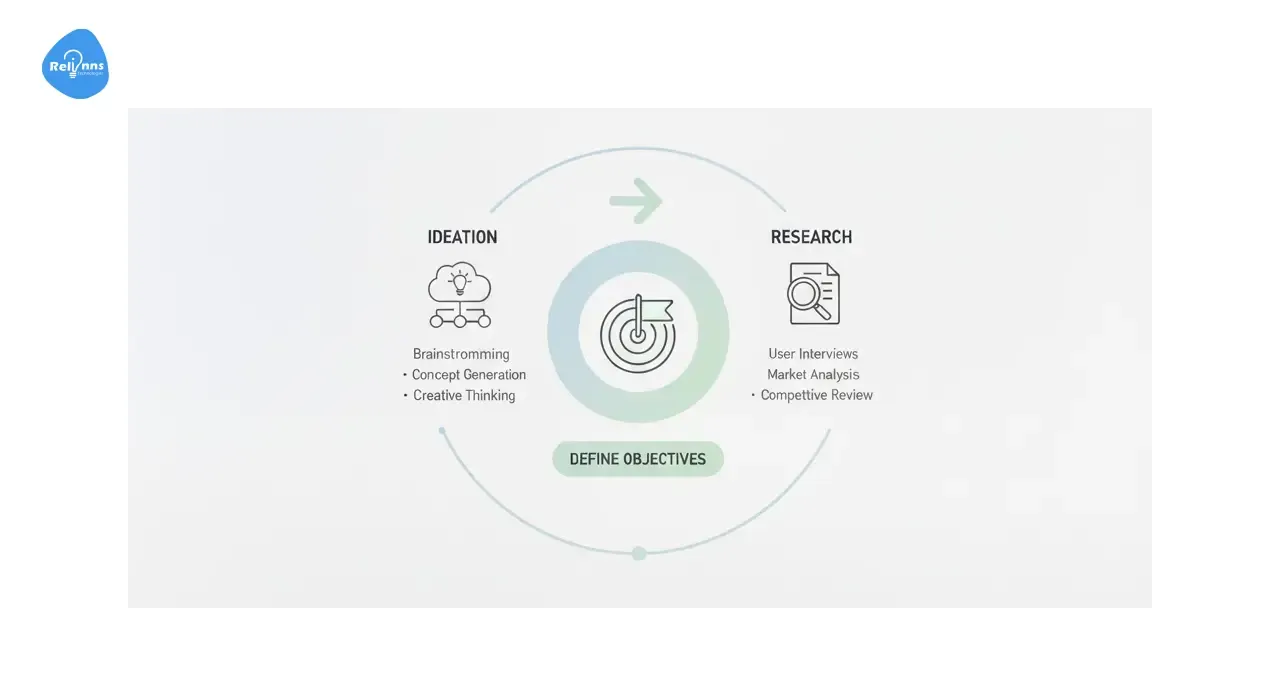
Every app starts with an idea, but ideas need clarity. At this stage, you define the purpose of your app and the problem it aims to solve.
Ask questions like:
- Who is the target audience?
- What pain points will the app address?
- What goals should the app achieve?
Example: An eCommerce startup may validate the idea with surveys, asking users if they’d prefer mobile shopping over web-only access. Research ensures the app is built on real needs, not assumptions.
2. Planning and Analysis – Researching the Market
Once the idea is validated, it’s time to map out how it will work. This involves competitor analysis, feature selection, and platform choice (iOS, Android, mobile app development process, and both).
Key steps include:
- Define the app’s core features.
- Estimate budget and resources.
- Select the right technology stack.
For example, a food delivery app may analyze competitors like Zomato or Uber Eats to identify gaps, such as loyalty rewards or faster payment options.
3. Design – Creating Intuitive UI/UX
Design is where the user journey comes to life. We use wireframing, UX/UI Design, and Prototyping to create intuitive user journeys. Important steps here:
- Wireframes: Basic blueprints for screens.
- Prototypes: Interactive models to test navigation.
- UI/UX Design: Visuals, colors, and interactions.
A poorly designed app often fails, no matter how good the idea is. On the other hand, a clean, user-first design encourages retention.
For Example, in a fitness app, designers create wireframes for workout screens, test navigation with prototypes, and refine visuals for a clean, motivating experience that keeps users engaged.
4. Development – Building the App
During this phase, both frontend and backend coding take place with smooth Backend Integration, guided by the agile mobile app development process, where APIs, databases, and server logic connect seamlessly.
The Agile methodology is commonly used, meaning work is done in small, iterative cycles. This helps teams test, adapt, and refine features quickly.
Many businesses prefer hiring an app development company to ensure professional coding standards and timely delivery.
For Example, a food delivery app where the frontend displays menus and the backend handles orders, payments, and delivery tracking.
Suggested Reading: 10 Best AI App Development Companies in 2025
5. Testing – Quality Assurance
An app cannot launch without rigorous testing. Bugs or poor usability can quickly destroy credibility.
Types of testing include:
- Functional Testing: Does every feature work
- Usability Testing: Is the App Intuitive?
- Security Testing: Are User Data and Payments Secure?
Example: A banking app must be tested for both functionality and security before release, as errors could result in financial losses for users.
6. Deployment – Launching the App
Once testing is complete, the app is submitted to platforms like the App Store (iOS) and Google Play (Android). Each store has strict guidelines, so compliance is crucial.
For example, once thoroughly tested, a meditation app is submitted to the Google Play Store and Apple App Store, ensuring it meets each platform’s guidelines before going live for users to download.
Pre-launch tasks often include:
- Creating an app store listing with descriptions, screenshots, and videos.
- Marketing preparation, like teaser campaigns.
- We will soft launch with a smaller audience for final feedback and refinement.
7. Maintenance – Post-Launch Activity
The process doesn’t end at launch. In fact, maintenance is ongoing. Regular updates, bug fixes, and performance improvements keep the app relevant.
Example: An e-commerce app may later add payment options, such as UPI or PayPal, based on customer demand.
Together, these steps form the backbone of the enterprise mobile app development process.
What are the challenges in the mobile app development process?
A good idea alone doesn’t guarantee app success. Many projects struggle because teams underestimate the complexity of the mobile app development process.
Knowing the common challenges early helps avoid these obstacles promptly.
- Budget overruns: Costs can spiral out of control when features are added mid-project or resources are miscalculated.
- Unrealistic timelines: Rushing to launch often means skipping testing or cutting corners on design. This leads to buggy apps and frustrated users.
- Unclear goals: Apps without a defined purpose tend to pile on unnecessary features. Rushing often skips testing and QA, leaving unsolved problems, confusing users, and reducing engagement.
- Poor communication: When developers, designers, and business leaders aren’t aligned, rework becomes common. This slows progress and increases costs.
- Evolving technology: Mobile frameworks and operating systems change quickly. Apps that aren’t updated risk becoming outdated or incompatible.
- Security risks: Without proper data protection, apps become vulnerable to breaches, which can damage both user trust and brand reputation.
- Scalability issues: Many apps are built to meet immediate needs but fail to handle growing user bases, increased traffic, or new features.
- User adoption challenges: Even a well-built app can fail if the onboarding process is poor or the app doesn’t meet user expectations.
- App Store approval: Both the Apple App Store and the Google Play have strict guidelines. Failure to meet them can delay or even block an app’s release.
- High competition: With millions of apps already available, standing out in the crowded market is a constant challenge.
These challenges are not deal-breakers, but they can be solved with proper planning and processing.
For enterprises, these issues highlight the importance of choosing the right enterprise mobile app development process and a trusted partner.
What are the common pitfalls in the mobile app development process?
Many issues in the mobile app development process stem from recurring mistakes. These pitfalls can slow progress or derail the project entirely:
- Overcomplicating features – Packing too many functions into the first version makes apps heavy, confusing, and more challenging to maintain.
- Skipping user feedback – Ignoring real users during testing often results in apps that fail to meet customer needs.
- Neglecting security – Overlooking encryption, permissions, or secure coding leaves apps vulnerable.
- Underestimating updates – Some teams treat launch as the finish line, but without regular updates, apps quickly become outdated.
How to Overcome Such Pitfalls?
Overcoming these issues requires discipline and planning. Here’s what works best:
- Prioritize MVP (Minimum Viable Product) – Launch with only essential features. This reduces costs, speeds up the release, and allows you to test the market early.
- Adopt agile methodology – Work in smaller iterations with regular check-ins. This keeps communication clear and progress transparent.
- Listen to users – Gather reviews, run beta tests, and track analytics to refine the app based on actual behavior.
- Plan for long-term support by scheduling updates, security patches, and feature improvements as part of the roadmap, not as an afterthought.
These steps don’t just address short-term issues; they also establish a solid foundation for long-term success and scalability.
Smooth processes matter as much as strong ideas. Next, let’s see how the timeline and cost factors shape mobile app development projects.
How Much Does It Cost to Develop a Mobile App? (Timeline and Cost Factors)
Every business wants to know two things before starting an app project: how long it will take and how much it will cost. The answer depends on the scope, complexity, and goals of the app. While timelines vary, averages help set realistic expectations.
A simple app with limited features, such as login, user profile, and basic notifications, usually takes 3–4 months to build. A medium-complexity app with features such as in-app payments, real-time chat, or geolocation can take 6–9 months to develop. A complex app with advanced integrations, AI, or custom backend systems may take anywhere between 9 and 15 months or more.
Costs grow in the same direction. A basic app may cost you $5K-$10K, while advanced apps with multiple platforms and complex features can cost $60K to $150K.
In 2026, current market estimates suggest:
- A simple / MVP app often falls in the USD 20,000 to 50,000 range.
- A medium-complexity app typically costs USD 60,000 to 150,000.
- A complex or enterprise-grade app can easily exceed USD 200,000+.
Planning carefully helps avoid unexpected overruns.
The main factors affecting app cost and timeline include:
- Feature set – Each new feature means extra design, coding, and testing.
- Wireframing and UX/UI Design quality – Creating custom, polished interfaces requires more time than using ready-made templates.
- Platform choice – Developing for both iOS and Android mobile app platforms increases effort compared to a single platform.
- Tech stack and integrations – The complexity of payment gateways, backend integration, and APIs can significantly extend development time.
- Developer expertise – Skilled teams may charge higher rates, but they also reduce errors and delays.
Let’s look at this breakdown of these factors and get a deeper understanding of how things work here:
Timeline Breakdown
Every mobile app development process follows a sequence of stages, and each stage demands its share of time. Here’s a rough estimate for typical projects:
- Research & Ideation: 2–3 weeks (understanding goals, audience, and feasibility).
- Planning & Analysis: 2–4 weeks (competitor research, feature list, budget planning).
- Design and Prototype (UI/UX): 3–6 weeks (wireframes, prototypes, user flow testing).
- Development Sprint: 2–6 months (frontend, backend, integrations, APIs).
- Testing & QA: 3–5 weeks (functional, performance, and security checks).
- Deployment & App Store Submission: 1–2 weeks (App Store and Google Play approvals).
- Post-launch Maintenance: Ongoing (updates, bug fixes, scaling).
Cost Factors to Consider
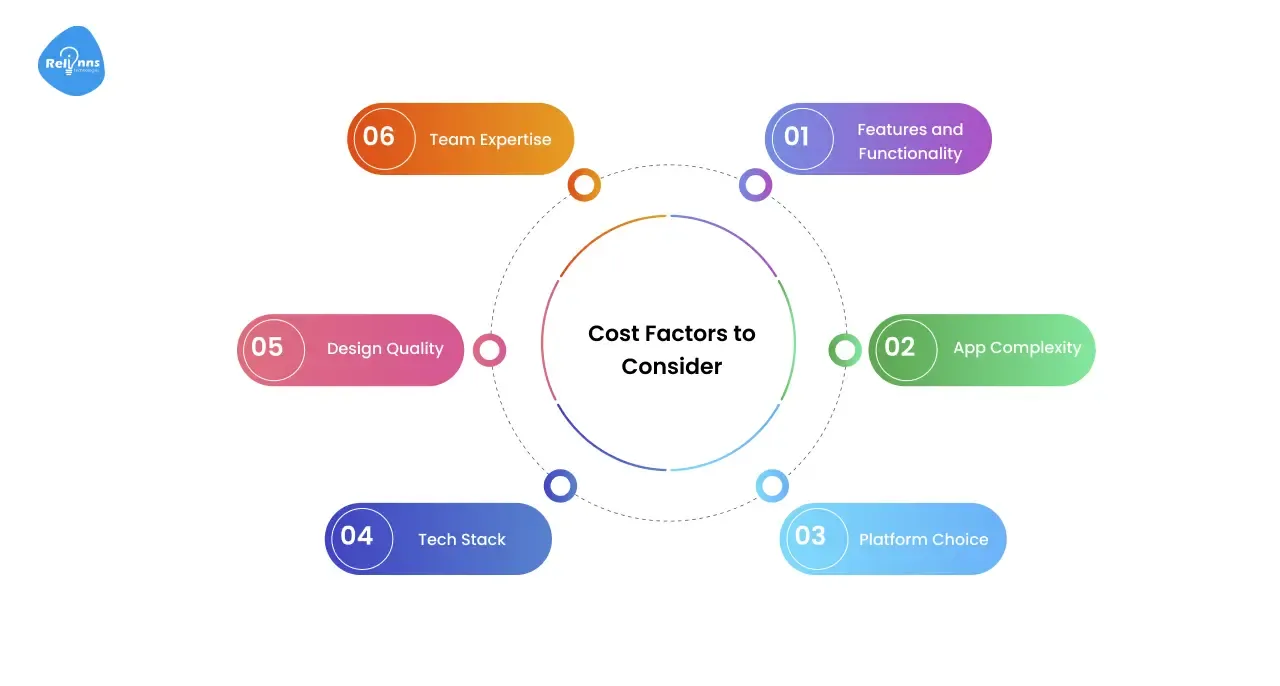
Several factors contribute to the cost of developing a mobile app. The most significant factors include:
- Features and Functionality: More features equal more coding, testing, and iterations.
- App Complexity: Simple apps cost less, while advanced apps with AI or custom backends demand higher budgets.
- Platform Choice: Building for iOS and Android together increases both cost and effort.
- Tech Stack: Specialized frameworks or tools can raise costs but improve performance.
- Design Quality: A sleek, custom UI/UX design takes longer and costs more than a basic layout.
- Team Expertise: Hiring an experienced development company ensures quality, but comes at a premium.
What are the new technologies in mobile app development?
Apps today must go beyond the basics. Users want speed, personalization, and more innovative features.
To meet these expectations, businesses are utilizing new technologies that enhance the power and user-friendliness of their apps.
Here are the key innovations shaping mobile app development:
1. Artificial Intelligence (AI) and Machine Learning (ML)
AI and ML enable apps to learn from user behavior and enhance experiences. They are used for:
- Chatbots for instant customer support.
- Personalized recommendations (e.g., shopping apps).
- Fraud detection in finance apps.
2. Internet of Things (IoT)
Apps can now connect with everyday smart devices. Examples include:
- Fitness apps linking with wearables.
- Home automation apps control lights and appliances.
- Vehicle apps for real-time monitoring.
3. Augmented Reality (AR) and Virtual Reality (VR)
These technologies create interactive and immersive experiences. Use cases:
- Real estate apps offering virtual tours.
- Gaming apps with AR/VR elements.
- Retail apps let customers “try before they buy.”
4. Blockchain Technology
Blockchain adds security and transparency to apps. It is being used for:
- Secure transactions in finance.
- Data protection in healthcare.
- Building decentralized applications (dApps).
5. 5G Connectivity
The rise of 5G enables faster and smoother app experiences, such as:
- Real-time multiplayer gaming.
- High-quality video streaming.
- AR/VR apps with no lag.
6. Cloud-Based Mobile Apps
Cloud integration enables apps to run faster and handle a larger number of users. Benefits include:
- Less device storage usage.
- Easy scalability for growing businesses.
- Smooth performance during high traffic.
7. Voice Technology
Voice-enabled apps are becoming mainstream. They improve usability by:
- Offering hands-free navigation.
- Enabling quick searches and commands.
- Making apps more accessible.
8. Cross-Platform Development Tools
Frameworks like Flutter, React Native, and Kotlin Multiplatform enable the creation of apps for both iOS and Android using a single codebase, allowing for seamless development and deployment across multiple platforms. This means:
- Rapid Application Development (RAD)
- There are lower costs compared to building separate native apps.
- Consistent user experience across platforms.
9. Low-Code/No-Code Platforms
These platforms enable businesses to develop apps quickly without requiring extensive coding. They are helpful for:
- Startups with limited budgets.
- Rapid prototyping and testing.
- Empowering non-technical teams to create simple apps.
- Example: Joget, Mendix, Zoho
10. Beacon Technology
Beacons use Bluetooth to send signals to nearby devices. They are popular for:
- Retail stores are sending personalized offers to customers.
- Museums and events offering guided tours.
- Location-based marketing campaigns.
At Relinns, these new technologies are integrated into every project. These innovations make the enterprise mobile app development process future-ready.
Why Hire Relinns for Your App Development Process?
Relinns specializes in custom app development tailored to your business goals. Instead of rushing through stages, Relinns focuses on aligning the app with user needs, market trends, and business objectives.
Here’s what sets Relinns apart:
- User-first design: Features built to solve real user needs.
- Agile mobile app development process: Faster delivery with room for changes.
- End-to-end services: From idea to launch and beyond. Including end-to-end services covering Ideation, Wireframing, UX/UI Design, Development Sprint, Testing & QA, Deployment, and Post-Launch Maintenance.
- Budget-friendly solutions: Smart use of resources to cut costs.
- Future-ready tech: AI, IoT, and automation expertise.
- Post-launch support: Updates, fixes, and monitoring included.
- Proven results: Successful projects across multiple industries.
Conclusion
Building a mobile app is not just about having an idea; it's about executing it effectively. Success comes from following a clear and structured mobile app development process.
From Ideation and design to App Store Submission and Post-Launch Maintenance, every stage plays a role in shaping the final product.
We’ve seen how challenges, costs, timelines, and new technologies shape the development of a mobile app process. The right enterprise mobile app development process partner makes all the difference.
At Relinns, we bring process, expertise, and support under one roof. If you’re ready to start your journey, let’s build it the right way, together.
Frequently Asked Questions (FAQs)
How to develop and process forms in mobile apps?
Forms are created during the mobile app design and development process using native tools or frameworks. They validate input and securely transmit data to servers.
How will mobile apps change the development modeling processes?
Mobile apps emphasize the agile mobile app development process, faster updates, and cross-platform flexibility, making models more user-focused.
What are the crucial steps in the mobile app development process?
The essential mobile app development process steps include Ideation, Wireframing, UX/UI Design, Prototyping, Development Sprint, Backend Integration, Testing & QA, Deployment, App Store Submission, and Post-Launch Maintenance.
How Much Does It Cost to Develop a Mobile App?
The costs vary by complexity, features, and platform choice (iOS or Android mobile app development process). Simple apps cost a few thousand dollars, while advanced enterprise apps can reach hundreds of thousands.


